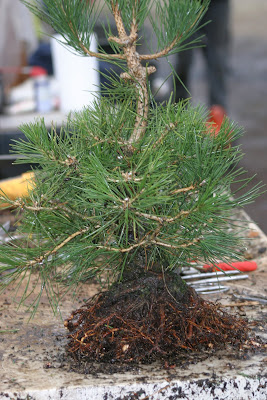 Some times when growing Japanese Black Pine, there is not an emphasis on total tree development. When the focus is using the trees natural physiological responses to accomplish what the goal is, then the total time in development is minimized.
Some times when growing Japanese Black Pine, there is not an emphasis on total tree development. When the focus is using the trees natural physiological responses to accomplish what the goal is, then the total time in development is minimized.While thinking of doing this blog, I purposely dedicated the contents to developing bonsai. There are numerous avenues for learning finishing technique but very few for getting there. Far to often the beginnings are not addressed or overlooked.Good Growing. Wood
Saturday, December 31, 2011
Black Pine Nebari
 Some times when growing Japanese Black Pine, there is not an emphasis on total tree development. When the focus is using the trees natural physiological responses to accomplish what the goal is, then the total time in development is minimized.
Some times when growing Japanese Black Pine, there is not an emphasis on total tree development. When the focus is using the trees natural physiological responses to accomplish what the goal is, then the total time in development is minimized.Monday, December 26, 2011
Trident Building Process
 I've been asked to go into a little more detail on the nebari building process. This tree is about 6years old. It began as 5 cuttings through a ceramic tile that was drilled with a 1\4" drill. The shape of the drill pattern is like a #5 on a di(ce) with the outside holes about 2" apart. Dormant cuttings were placed through the holes from the bottom and with no roots on the top side. As the trees grow it will fill the hole, swell at the base and layer itself on top of the tile with a symmetrical root system. These are allowed to grow for 2 seasons and then extensive rootwork is done. To get the best results for building the nebari, no top pruning is done. This slows down the top some because the tree is building enough roots to support the corresponding shoots, rapid root growth. Then it's just keeping the outside trees pruned to keep them small and the main tree unchecked. Alternate years of rootwork and shootwork.
I've been asked to go into a little more detail on the nebari building process. This tree is about 6years old. It began as 5 cuttings through a ceramic tile that was drilled with a 1\4" drill. The shape of the drill pattern is like a #5 on a di(ce) with the outside holes about 2" apart. Dormant cuttings were placed through the holes from the bottom and with no roots on the top side. As the trees grow it will fill the hole, swell at the base and layer itself on top of the tile with a symmetrical root system. These are allowed to grow for 2 seasons and then extensive rootwork is done. To get the best results for building the nebari, no top pruning is done. This slows down the top some because the tree is building enough roots to support the corresponding shoots, rapid root growth. Then it's just keeping the outside trees pruned to keep them small and the main tree unchecked. Alternate years of rootwork and shootwork.This round of work for this tree was washing the surface with high pressure water from the garden hose. Combing and untangling the annual surface roots and then cutting these surface roots. New soil will be added to the top so that the new surface roots will not dry. This coming year will be dedicated to growing the new leader that's close to the base where it will be cut in the future.
Sunday, January 2, 2011
Stewartia monodelpha
 Stewartia is almost the opposite of Trident in most of their growth responses, especially with roots and callus. They are very difficult to build impressive nebari so it's critical to start their root work early. Layering Stewartia is a slow process and then the basal flair is not so pronounced. This is a seedling grown through a ceramic tile and took three years to get this result.
Stewartia is almost the opposite of Trident in most of their growth responses, especially with roots and callus. They are very difficult to build impressive nebari so it's critical to start their root work early. Layering Stewartia is a slow process and then the basal flair is not so pronounced. This is a seedling grown through a ceramic tile and took three years to get this result.
Subscribe to:
Comments (Atom)
